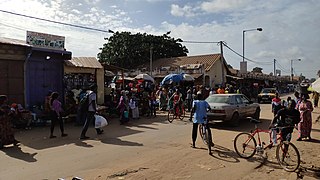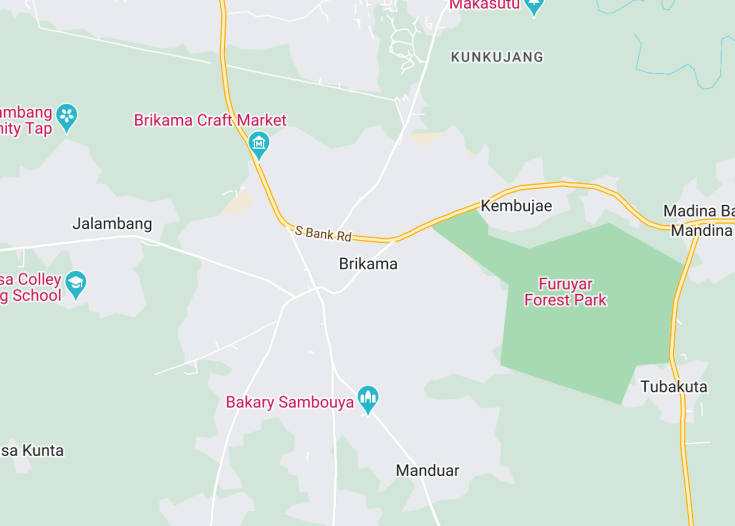Brikama, located in the Western Division of The Gambia, is a vibrant city known for its rich culture and artistic community. Renowned for its bustling market and the craftsmanship of local artisans, especially wood carvers, Brikama offers a plethora of traditional crafts and musical entertainment. The city serves as a hub for both the economic and cultural activities in the region, drawing visitors to experience its lively performances and explore the surrounding lush landscapes. This destination provides an intimate glimpse into the Gambian way of life, ideal for travelers seeking a blend of cultural immersion and natural beauty.
Remember to visit the Brikama craft market early in the morning to avoid the sweltering afternoon heat and to have the best selection of artisanal goods.
Plan your visit to include a live performance by local musicians, offering an authentic experience of Gambia’s thriving music scene.
Top things to do & see in Brikama
Select the following sights and activities to discover best tickets and tours available in Brikama.
Brikama: The Vibrant Gateway to Gambia
| Country | Gambia |
| Time in Brikama | GMT+0 |
| Language spoken | Mandinka |
| Population | 57,000 (World Population Review) |
| Currency | Gambian dalasi (GMD) |
| Airports |
|
Brikama, located in the Western Division of Gambia, is the largest city in the region and the second most populous urban center in the country after the capital, Banjul. Positioned near the border with Senegal, Brikama is not only a bustling market town but also a rich cultural hub, offering a unique blend of traditional Gambian arts, crafts, and music. The city is known for its craft market—renowned for wood carving, among other crafts—allowing locals and tourists alike to witness the rich artistic heritage of Gambia.
Historically, Brikama has held significant importance due to its position on various trade routes which facilitated commerce and cultural exchange within West Africa. This significance is reflected through diverse ethnic groups present in Brikama, contributing to a melting pot of cultures, languages, and traditions. Despite modern influences, the city still holds onto its roots with traditional dwellings and communal compounds commonly found throughout the area.
The city’s vibrancy is further evident in the annual events and festivals, celebrating cultural heritage and attracting visitors from around the globe. With its proximity to the coast, Brikama also serves as a strategic hub for exploration into the picturesque landscapes and rich biodiversity of Gambia. The community here reflects a blend of historical resilience and modern growth, making Brikama an essential stop for anyone visiting Gambia.
Where is Brikama?
Brikama is prominently located in the Western Division of Gambia, a short distance southeast of the capital city, Banjul.
Distances:
| Route | Distance by car | Time by car |
|---|---|---|
| Banjul to Brikama | 20 miles / 32 km | 40 minutes |
| Serekunda to Brikama | 10 miles / 16 km | 20 minutes |
| Farafenni to Brikama | 76 miles / 122 km | about 2 hours |
What is Brikama famous for?
Brikama is best known for its vibrant arts scene, particularly in wood craftsmanship. It is also celebrated for its cultural diversity and as a crucial hub in Gambia’s economic and social landscapes.
History
Pre-colonial Era (Before the 19th Century)
Brikama, one of the largest towns in Gambia, has a rich history that traces back to centuries ago when it was primarily settled by the Mandinka people. The area was known for its strategic position in trade routes and as a community centered around agriculture and craftsmanship. The Mandinka, known for their deep-rooted cultural heritage, played a crucial role in the spread of Islam in the region, influencing the social and spiritual framework of Brikama.
Colonial Period (19th Century–1965)
During the colonial period, Brikama came under British influence as part of the wider territorial outlines of The Gambia. This era saw the introduction of formal education and infrastructural developments such as roads. The town served as a center for administrative and trading endeavors due to its proximity to other major towns and the Gambian capital. However, it maintained much of its cultural integrity and continued to flourish as a center for traditional craftsmanship, particularly woodworking.
Post-Independence Era (1965 to Present)
Since Gambia’s independence in 1965, Brikama has seen significant growth both demographically and economically. It has expanded into a vibrant local economy primarily driven by trade, agriculture, and tourism. The town is especially renowned for its music scene and woodcarving industry, attracting enthusiasts from around the world. Despite modern influences, Brikama has retained its cultural essence, visible in its local festivals and the daily lives of its inhabitants.
Visit Brikama
What to see and do in Brikama, Gambia
Visitors to Brikama can immerse themselves in a vibrant tapestry of culture and nature. Key attractions include:
- The Brikama Craft Market, renowned for exquisite woodcarvings and local artistry.
- Music venues showcasing local talents, reflecting Brikama’s reputation as a hub for Gambian music.
- Nearby nature reserves, offering a glimpse into The Gambia’s lush wildlife and landscapes.
The town provides a unique opportunity to experience the rich cultural heritage and lively atmosphere of one of Gambia’s most dynamic locales.
Annual Cultural Festivals and Crafts
Brikama is host to several cultural festivals throughout the year, notably the Brikama Cultural Festival. Held annually, this event features a display of local music, dance, and craftsmanship that attracts visitors from across the globe. These celebrations are usually vibrant during the dry season, offering deeper insight into the community’s rich traditions and social fabric.
Best time to visit Brikama
The most favorable time to visit Brikama is during the cooler dry season, from November to February. During these months, the climate is most pleasant, and many of the town’s cultural festivities take place, providing visitors with an enriching experience of Gambian culture and hospitality.
Is Brikama worth visiting?
Brikama offers a unique glimpse into the heart of Gambian life and culture. It is celebrated for its bustling craft market, vibrant musical scene, and rich history. However, visitors should be prepared for a less polished experience, as the town does not typically cater to mass tourism, which can be both a charm and a challenge. The local infrastructure may seem lacking compared to more developed tourist destinations. Yet, for those interested in an authentic cultural experience and the opportunity to see Gambian craftsmanship at its finest, Brikama is definitely worth the visit.










